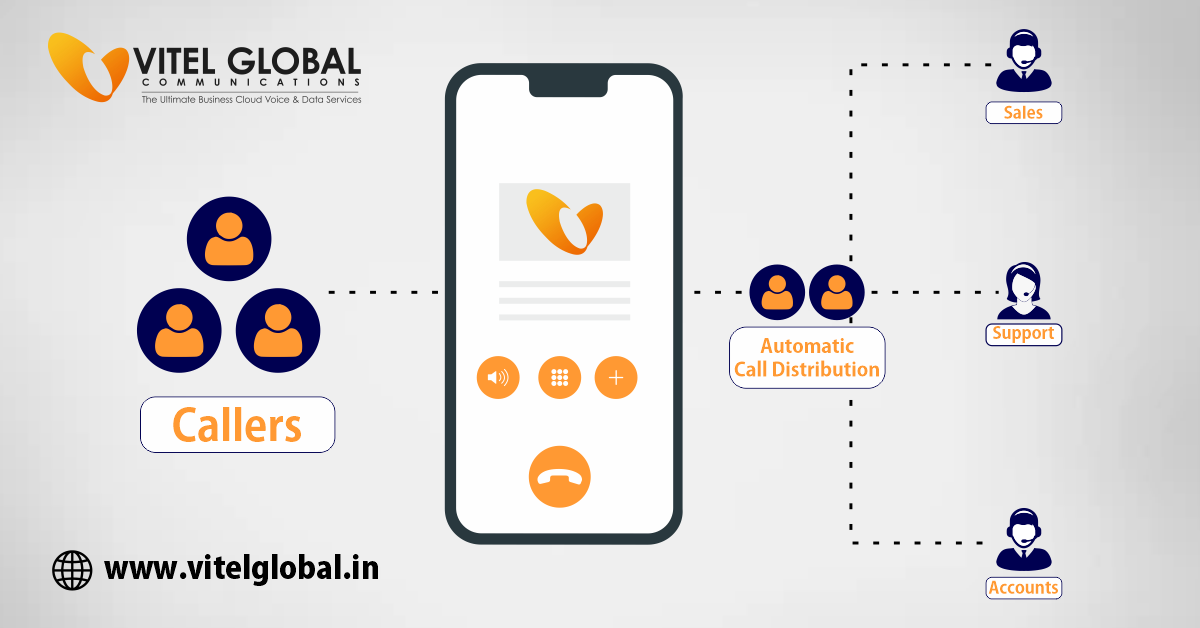Table of Contents
Automatic Call distribution (ACD) is a VoIP feature that serves the purpose of routing customer calls to appropriate agents in the concerned department.
It is unlike IVR. It collects relevant data from the customer and enables them to self-service. ACD can control the call flow by distributing calls to appropriate terminals.
What is Automatic Call Distribution (ACD)?
ACD is a feature of business phone system software that picks up incoming calls. It directs them to a particular employee or division within a firm relevant to the issue. With ACD, you use pre-set rules and criteria to decide where the calls are routed.
The system can divide the calls according to caller ID, business hours, help level, and IVR choices. As a result, inbound calls are routed to the appropriate agent or division without needing to dial a different number.
How does ACD Work?
ACD (automatic call distribution) aims to manage high call volumes and boost contact centers’ productivity. This increases the significance of client happiness throughout the call center.
However, when a person can get in touch with the right agent in the least amount of time, it is a gesture of customer satisfaction.
A major percentage of call center clients anticipate their problem to solve in only one call. According to the latest survey, a provider of analytics software, every follow-up encounter cannot be avoided. This results in a remarkable decrease in consumer satisfaction for the brand.
When you are aware that one of the most important call center metrics is first-to-call resolution (FCR), you can estimate the resolution rate. If you accurately measure the resolution rate, you can optimize a variety of processes.
- Low operational expenses
- Reduce turnover of customers
- Employee engagement
- Enhance user experience
- Real-time dashboards and analytics
- Boost customer referrals
Yet, understanding the main causes of first-call performance will help us better understand how automatic call distribution can be of assistance.
Even when a problem is clear, an underperforming contact center team might frequently lack the authority to remedy it. They can also lack the expertise or experience necessary to efficiently handle client calls. This phenomenon requires you to set up call monitoring to hear calls in real time or previous call recordings if you’re unsure.
Now, imagine how it feels when a customer contacts the wrong person about a problem. It takes place often. Consider how much an ideal customer care representative may affect the general client experience.
To answer this question, take into account all the call routing options offered by your phone system provider. You may manage more calls in a more considerate, better method with the help of automatic call distribution technologies.
How does ACD Automatic Call Distribution Operate?
Factually, when determining where to divert an inbound call, an ACD takes into account its specific characteristics. The dialed number, the caller’s phone number, the availability of contact center agents, and other data sources are all evaluated.
Thus, ACD distributes an agent’s calls by the following strategies. Additionally, as customer care representatives log in and out during the day, the ACD keeps track of their availability. Other considerations include talents, time of day, and the languages that your agents speak.
Now, let us go through a stepwise elaborated description:
Determine the purpose of the call:
It is essential to determine the nature of the incoming call. An interactive voice response (IVR) can offer callers options to explain why they are calling. Dialed Number Identity Service (DNIS) that functions similarly to reverse caller ID for call centers can (on the other hand) determine the reason for the call.
Control the call queue:
Coming to the next level of operation is to put the calls in the right queue so that an agent can answer them. If agents are not taking calls, there is no need for a call queue. As a result, the ACD also keeps track of calls that are on hold.
The call queues stand in the following order by the automatic call distribution system:
- Status of the agent
- Wait time of the caller
- Customer data
Make phone calls:
Call handling and termination are the final steps in the ACD routing process. People don’t want to wait on hold to talk to a real person. A call-back option may be provided by the virtual phone system, saving their place in line and allowing them to continue with other tasks. The ACD also works to keep track of all of these stages and call logs for later analysis.
Although configuring an ACD algorithm may sound difficult, setting up ACD is relatively simple. Depending on your company’s requirements, you can customize the routing strategy.
The characteristics of the available agents are one illustration of a routing strategy. This enterprise PBX feature is useful for internal transfers as well as for incoming calls. It takes into account a person’s Computer Telephony Integration (CTI) status. It is versatile and can be on hold, on break, or ready to take on more calls.
Your calls are routed by a hosted contact center in accordance with your predetermined criteria. The various call routing options available with an ACD will be discussed next.
The requirements of your company and the capabilities of your call center software provider determine this type of automation. You need to know which metrics are most important to your business in order to determine the best routing strategy.
Conclusion:
For any company which is expanding, automatic call routing is very crucial for managing the call flow and an automatic call distribution feature is made for the task.
Vitel Global stands in the frontline of the best business VoIP service providers across the globe. To know more about our services with respect to ACD and affordable business plans that suit you.
VitelGlobal promises the highest uptime simple system administration and quick addition of new members from anywhere in the world. Additionally, all of your staff can connect easily regardless of the devices they each use. Why not request a demo today?





